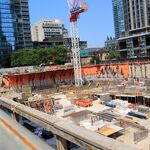http://www.worldchanging.com/archives/009726.html
A Suburban Future of Concrete and Gardens -- Nice. Right?
Julia Levitt
April 24, 2009 1:29 PM
Could Toronto's aging concrete high-rises be North America's most promising new frontier for sustainable suburban development? A new City-backed plan is banking on it. The Mayor's Tower Renewal aims to turn the greater Toronto metropolitan area's 1960s apartment blocks into a 21st century resource, around which sustainable, walkable, mixed-use suburban hubs of community and economic opportunity can be built. In so doing, Toronto could create a model of successful density for the rest of the continent, and perhaps for the world.
The plan originated from ongoing research at the University of Toronto, and the work of Graeme Stewart, both as a graduate student and later with ERA Architects. The research recognized the potential value of these nearly 1,000 buildings. The Tower Renewal Project comprises a series of comprehensive recommendations for reviving these concrete housing communities so that they provide the high quality of life they were intended for, using the 21st century understanding of sustainable development. In September last year, the plan was adopted by Toronto's City Council and Mayor David Miller, and in January, the City identified four pilot sites and launched a new corresponding civic department.
The residential density provided by the apartment towers has been a big asset to Toronto. In the post-WWII era, these towers dominated new housing construction in the first-ring suburbs – some as far as 40km from the urban center. In 1968, Buckminster Fuller recognized the high-rises as "a type of high-density suburban development far more progressive and able to deal with the future than the endless sprawl of the U.S." Today, Toronto's metro area boasts an average density of 26.5 units/hectare – denser than comparable North American metro areas (including New York), and even ahead of sustainability leader Vancouver.
But the post-war development didn't do density right, and the shortfalls are now becoming clear. The towers are reaching the end of their original lifespans, and have become some of Toronto's biggest energy sieves, with leaking windows and woeful insulation. The neglected, inefficient buildings now house Toronto's most impoverished residents, many of them new immigrants. And because of outdated residential zoning, residents find themselves in a paradox of dense sprawl: apartment communities with as many as 30,000 residents remain isolated from grocery stores, green space and other basic community amenities. To an outsider, the towers seem poised to become a 21st century version of Cabrini-Green, the Chicago housing project (now undergoing redevelopment) which in the 1990s became synonymous with the worst problems associated with low-income housing and urban density: drugs, violence, gangs, poverty and physical deterioration.
But the towers already have nearly everything they need to become the opposite: a model for sustainable, prosperous, bright green urban density. The sturdy housing structures are surrounded by green space (as much as 80 percent of each property is devoted to open parkland), and arranged closely enough to provide ideal nodes for public transit and mixed-use development. The difference between failing and winning here is just a matter of using the pieces correctly.
The first step is to bring the buildings up to date. "The benefit is, these buildings were built like tanks. They could last for several more generations, so tearing them down doesn't make any sense. It would cost a lot more to tear them down, both economically and socially, than to just re-invest and make them work," says Stewart.
The City will achieve an enormous reduction in carbon by retrofitting the aging towers for energy efficiency with overcladding of walls and balconies, new windows, updated HVAC and mechanical systems, and even possibly newer green building options like geothermal heating, solar water heating and photovoltaics, living roofs, stormwater retention and graywater recycling. Dr. Ted Kesik, professor in the Faculty of Architecture, Landscape, and Design at the University of Toronto, is leading the effort to research specific retrofit technology.
Though the refitting could cost $4 to $5 million per building, the cost of replacing a 20-story tower apartment is between $50 and $60 million, according to a report prepared by Kesik, ERA and others. Upgrades could cut energy costs for each building by as much as half, and the report predicts they will pay for themselves within 10 to 12 years.
The next step: improving the space. ERA wants to solve the problem of isolation by replacing the bland lawns that surround so many of these properties with the amenities that will turn the apartment communities from economic and service deserts into oases. According to some ideas they propose in their Mayor's Tower Renewal Opportunities Book, these untapped green spaces could be cultivated as urban food and native plant gardens (like the Federation of City Farms has done for years in the UK). Changes to outdated zoning laws would also open up many other options for this spaces: public recreation, space for district energy or on-site wastewater management systems, or space for new housing, retail and other mixed-use development that would allow landlords to recoup the cost of retrofitting towers, and enable residents to work and shop without commuting.
"Right now neighborhoods offer residential density, but they're employment and service deserts," says Stewart. "The idea that to solve it, you would add more density seems sort of strange -- and I think that's going to be the biggest point of contention to the neighboring areas -- but at the same time, during early engagement with the communities, people are saying, 'I'd like a grocery store,' 'I'd like to be able to open up a small business.' It almost seems like a no-brainer. The fact that these neighborhoods have been ignored and stayed the same for so long is actually what's weird about them."
Over the next two years, the architects, planners and other decision-makers involved with the Tower Renewal will turn the four pilot sites into models for as many of the proposed changes as possible. At the end of the trial, they will propose a set of recommendations for changing City zoning codes and regulations – policies that have been unchanged since the 1960s – to govern smarter and more sustainable development of the many dozen similar apartment communities across the region.
That brings us to the project's final leg, which is institutional. The people behind the Tower Renewal, including those in the Mayor's office, are betting on its big-picture potential to change the city bureaucracy, and its approach to region-wide policy and preparation for growth. The decisions for the apartment communities -- from energy planning to land-use codes to transit planning -- normally segregated among many departments, will be housed under one roof in an attempt to make the project run smoothly and to achieve measurable results.
Measurement will be key, because about 80 percent of the buildings are privately owned. Stewart and others know that in order to convince owners to invest millions into upgrading their properties -- yet still maintain affordable housing -- there must be the promise of a return, whether from energy savings or new development opportunities. And Stewart says there is also potential to work with third-party partners like the Clinton Foundation or C40 Cities Climate Leadership Group on funding opportunities, or on new loan products to help encourage efficiency and neighborhood upgrades (for more ideas for financing retrofits in the private building sector, see our recent interview with Ed Mazria.)
Though Toronto's concrete neighborhoods are a unique problem in North America, this type of post-war housing is widespread in Europe and the former Soviet Union. Cities like London, Moscow and Berlin have already gone through the process of updating and integrating their own apartment blocks, and the Tower Renewal team has built connections with planners in those cities through their involvement in the C40.
"We're in a lucky position to be able to cherry-pick the best ideas," Stewart says.




